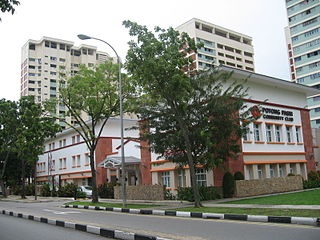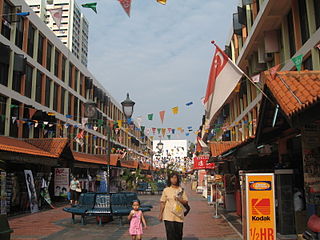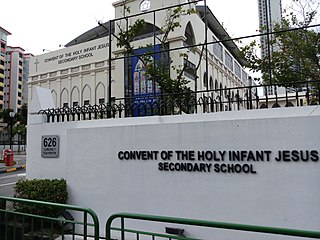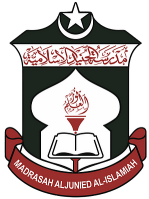
Madrasa is the Arabic word for any type of educational institution, secular or religious, whether for elementary education or higher learning. The word is variously transliterated Madrasah arifah, medresa, madrassa, madraza, medrese, etc. In countries outside the Arab world, the word usually refers to a specific type of religious school or college for the study of the religion of Islam, though this may not be the only subject studied.

Education in Singapore is managed by the Ministry of Education (MOE). It controls the development and administration of state schools receiving taxpayers' funding, but also has an advisory and supervisory role in respect of private schools. For both private and state schools, there are variations in the extent of autonomy in their curriculum, scope of taxpayers' aid and funding, tuition burden on the students, and admission policy.
Kembangan is a subzone and residential precinct located in the town of Bedok in the East Region of Singapore. It consists largely of private residential areas and a small public housing estate along Lengkong Tiga.

Potong Pasir is a housing estate located between Toa Payoh and Sennett Estate in the Central Region of Singapore. For urban planning purposes, it is classified under the Toa Payoh area.

Toa Payoh is a planning area and mature residential town located in the northern part of the Central Region of Singapore. Toa Payoh planning area borders Bishan and Serangoon to the north, the Central Water Catchment to the northwest, Kallang to the south, Geylang to the southeast, Novena to the west and Hougang to the east. Toa Payoh New Town is situated in the western portion of the Toa Payoh planning area. The latter occupies a much larger area, encompassing estates such as Potong Pasir and Bidadari.

Islam constitutes the third largest religion in Singapore, with Muslims accounting for approximately 15.6% of the population, as indicated by the 2020 census. Predominantly, Singaporean Muslims are Sunni Muslims adhering to either the Shafi‘i or Hanafi schools of thought. The majority of the Muslim population, about 80%, are ethnic Malays, while 13% are of Indian descent. The remaining fraction comprises local Chinese, Eurasian, and Arab communities, in addition to foreign migrants. Buddhism and Christianity are the two larger religious affiliations in the country.

CHIJ Secondary (Toa Payoh) is a government-aided autonomous Catholic girls' secondary school in Toa Payoh, Singapore. Founded in 1854, the school is the oldest of the 11 Convent of the Holy Infant Jesus (CHIJ) schools in Singapore. The school is currently recognised as a Centre of Excellence for Language and the Arts.
The Majlis Ugama Islam Singapura (MUIS), also known as the Islamic Religious Council of Singapore (IRCS), is a statutory board of the Ministry of Culture, Community and Youth of the Government of Singapore. As a majlis, its role is to look after the administration and interests of Singapore's Muslim community. The Majlis is headed by a Council, in which members are appointed by the President of Singapore. Since 2009, the council is headquartered in the Singapore Islamic Hub, along Braddell Road.

CHIJ St. Nicholas Girls' School (SNGS) is a government-aided autonomous Catholic girls' school in Ang Mo Kio, Singapore. The school is one of 11 Convent of the Holy Infant Jesus (CHIJ) schools in Singapore and one of the designated Special Assistance Plan (SAP) schools. It offers a six-year primary education in its primary school section and a four-year secondary education in its secondary school section. Since 2013, it has partnered with Eunoia Junior College for a six-year Integrated Programme, which allows its secondary school students to skip the Singapore-Cambridge GCE Ordinary Level examinations and proceed to Eunoia for Years 5 and 6 and take the Singapore-Cambridge GCE Advanced Level examinations at the end of Year 6.

Whitley Secondary School (WSS) is a co-educational government secondary school located in Bishan, Singapore.

Beatty Secondary School is a co-educational government secondary school in Toa Payoh, Singapore. It was established in 1953 along Beatty Road and moved to its current site in Toa Payoh in 1982.
Madrasah Al-Ma'arif Al-Islamiah is an all-girls' Islamic school, commonly known as madrasah, in Singapore. Al-Ma'arif has students at primary, secondary and pre-university levels. It is one of six full-time Islamic madrasahs in Singapore. Unlike most of the other madrasahs, Al-Ma'arif's curriculum places equal emphasis on Islamic religious studies and secular subjects from the Singapore Ministry of Education curriculum.

Madrasah Irsyad Zuhri Al-Islamiah is a full-time co-educational madrasah offering primary education in Singapore. Madrasah is an Arabic word that means "school" but in the present context a madrasah means an Islamic religious school. "Irsyad" means rightly guided in Arabic.
Maahad Muhammadi Lelaki or Maahad Muhammadi Lilbanin is a prominent Islamic secondary school in Kelantan, Malaysia. It is located at Jalan Pengkalan Chepa, Mukim Padang Bongor, Kota Bharu. The school is state-funded and governed by the Islamic Foundation of Kelantan.
The National University of Singapore Muslim Society (NUSMS), which used to be called the University of Singapore Muslim Society (USMS) or Persatuan Mahasiswa Islam Universiti Singapura (PMIUS), was established in 1963 to provide a platform for students and staff to engage in activities that serve the Muslim community on campus. It is a student-run organisation registered with the Registry of Societies and is currently managed by the 54th Executive Committee (ExCo).

Madrasah Aljunied Al-Islamiah is a full-time, private Islamic institution of learning in Singapore, one of the six such madrasahs in Singapore. Madrasah Aljunied is one of the oldest surviving madrasahs in Singapore. Through its years, it has gained eminence for its high standard of Arabic language and Islamic scholarship in the region. Madrasah Aljunied boasts an illustrious line of alumni of prominent Islamic religious leaders in Singapore and Southeast Asia.
Madrasahs in Singapore are full-time, religious institutions that offer a pedagogical mix of Islamic religious education and secular education in their curricula. While the Arabic term 'madrasah' literally translates to 'school', whether religious or secular, the term 'madrasah' is legally and colloquially defined in Singapore today as an 'Islamic religious school'. There are currently six madrasahs in Singapore offering primary to tertiary education, namely, Aljunied Al-Islamiah, Irsyad Zuhri Al-Islamiah, Al-Maarif Al-Islamiah, Alsagoff Al-Arabiah, Al-Arabiah Al-Islamiah, and Wak Tanjong Al-Islamiah. Four of them are co-educational, while the other two offer madrasah education exclusively to girls.
The Singapore Islamic Hub is a religious campus that houses Masjid Muhajirin, Madrasah Irsyad Zuhri Al-Islamiah and the headquarters of Majlis Ugama Islam Singapura (Muis). These institutions combined create a cohesive and symbiotic whole, embodies the Islamic principles of Iman, Ilmu and Amal respectively.

Madrasah Alsagoff Al-Arabiah is one of the six full-time Madrasahs in Singapore recognised by Majlis Ugama Islam Singapura (MUIS). It is known for its academic emphasis on its language and religious subjects.













